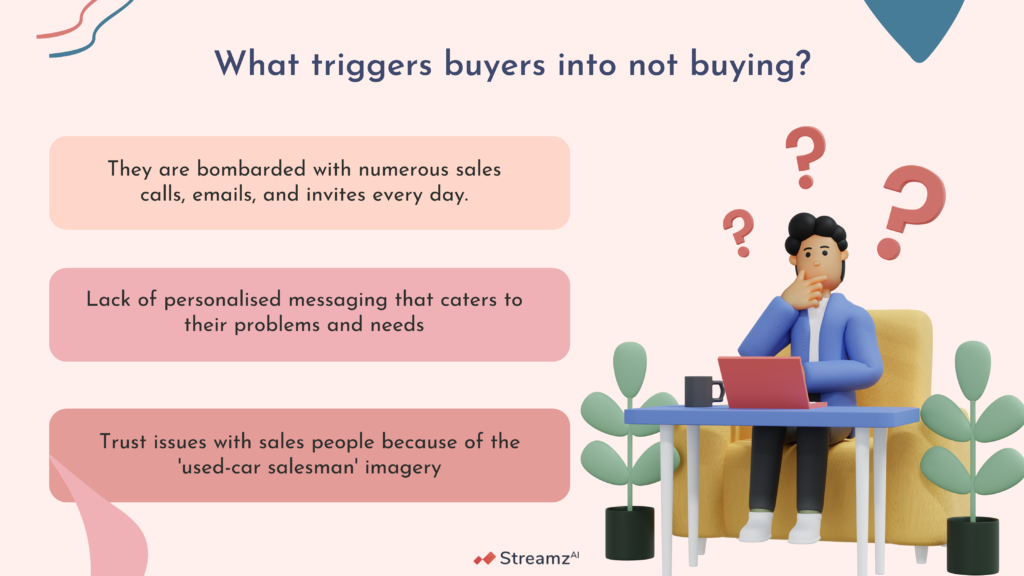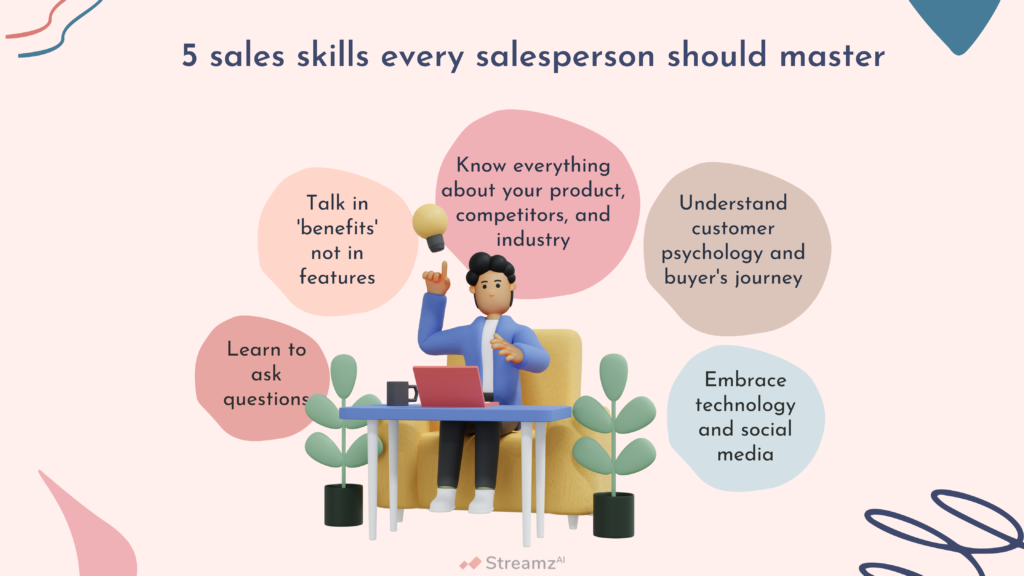Shobhana Menon
FEBRUARY 19, 2022
What triggers buyers into not buying?

1. They get cold calls every single day
Buyers are bombarded with emails, invites and calls every day. This translates to a lot of noise. Know that you’re not the only person reaching out to that one buyer. You’re competing against salesmen belonging to hundreds of different domains – other business software, real estate, insurance, car deals, shaving creams and the likes.
2. The perception that salespeople are self-absorbed
We’ve all received telemarketing calls that immediately start with talking about their product and themselves with no thought or regard about who they’re talking to. In fact, people mostly blacklist numbers to avoid the “pesky sales calls”.
3. Trust issues because of the ‘used-car salesman’ imagery
Another reason why buyers are suspicious of salespeople is that they have this perception that the latter only push their own interests. They often view sellers through the ‘used-car salesman’ trope – a person who is desperately trying to push the sale by manipulating the facts about the car. A trope associated with insincerity and with the reply “she’s not my problem anymore” if you find flaws with the car. The buyer has legitimate fears about promises not being kept, claims that don’t hold true, and features that fail to perform.
Taking these biases into account, organizations are now switching over from titles like – sales executive – to adopting more buyer-focused designations like – account manager or client manager or relationship executive.
That, and training them on core technical and behavioural sales skills in a fun and effective way, repeatedly will eventually lead to a drastic increase in their sales performances.
If you want to create a seismic impact on your year-end bottom lines, your executives must consistently focus on the following sales skills
- Learn to ask questions
- Talk in ‘benefits’ not in ‘features’
- Be the all-knowing oracle of your product, competitors and industry
- Introduce customer psychology in your sales skills training
- Embrace technology and social media

Learn to ask questions
Telling is not selling. Starting a conversation by droning about your features and services will, at best, have your buyers revert to you with a polite but insincere “sure, I’ll get back to you”. On the other hand, asking questions – specifically open-ended questions that begin with – what, how, which, when and who. Salesperson skills involve asking questions that don’t just warrant a ‘yes’ or a ‘no’ but end up giving you comprehensive, detailed answers.
Asking is one of the essential sales skills that give you a great opportunity to truly understand your buyer’s needs. With organizations today deploying manpower and money at scale to understand customer behaviour, a buyer giving you their time and an opportunity to understand their domain challenges are a pretty big deal in every sense of the word.
Prioritize learning to question over other sales skills because it’s easy to talk about your product for hours but framing questions that are relevant to your buyer’s profile requires a great deal of thought.
Your sales skills training could include asking basic questions like:
- How are you currently managing so-and-so tasks at the moment (without your product or service)?
- How is it working out for them so far?
- What are the problems they face consistently and want to resolve?
- How long have they worked at the company/industry?
- What does a perfect job done in their domain look like?
- What are the factors that they would consider to buy your product/service?
As a sales trainer, you must consistently guide your team to provide similar immersive experiences to prospects. When buyers respond with – “that’s actually a great question”, you know you’re on the right track.
Talk in ‘benefits’, not in ‘features’
Features tell but benefits sell. This makes communicating benefits to your buyers one of the essential sales skills.
“Here’s what our product can do” and “Here’s what you can do with our product” sound similar, but they are completely different approaches.“
– Jason Fried, co-founder and CEO of BaseCamp
While features focus on functionality, benefits cater to a buyer’s interest. The best way to arrive at benefits is to ask yourself the question – “So what?” – to every feature. Your product has carbon fibre frames – so what? The drink you sell has fewer calories – so what? Your software has an extensive reporting feature – so what?
Another point to keep in mind while sales skills training is to make use of the words ‘you’ and ‘your’ in your sentences as often as possible. So instead of saying – “Our product can make it easier to streamline workflows”, say – “Our streamlined workflows will help you launch your products faster to the market.”
If you have proven records of your existing customers benefiting from your product or service and if you have the numbers to back it up, feel free to use those stats shamelessly. Let’s reword our example and include an absolute number. “Our streamlined workflows will help you reduce your time-to-market by 43% making way for faster launches and increased revenues.”
Communicating creatively adds mojo to your teams’ sales skills.
Be the all-knowing oracle of your product, competitors and industry
Know what you’re talking about. Be insanely thorough about your industry, your competition, buying personas and more importantly – your product/service. If you can’t explain it to a six-year-old child, you don’t understand it yourself. And that’s coming from Einstein himself.
Commit to a routine of studying your product/service, your competitors and your buyers every day. Understand and memorize every possible aspect and utility of your product or service. Use it or see it perform first-hand until you start living and breathing it.
Explore digital solutions that can help your sales team access real-time content, structured for enhanced learning outcomes – anytime and anywhere. Such platforms offer optimized sales skills training content that is sliced into bite-sized sections for faster learning and retention. Quizzes, polls and activities are set in a gamified interface that rewards their reinforced learning, nudge them to complete their goals and monitors their performance.
Eventually, you’ll find yourself using creative ways to sell the product/service and overcome customer objections with little to no resistance.
Introduce customer psychology in your sales skills training
Learn to understand the buyer’s perspective. Empathize. It’s interesting to note that for a buyer, price and quality aren’t the top motivators to purchase your product or service. They’re thinking about how it will benefit them personally. Existing customers leaving positive feedback about your product will help convince them a step further.
A handy sales skill is to ask for testimonials from existing customers. This will help prove to prospects that they’re in good hands. Trust by association is a crucial aspect of the buying process and therefore must be included in your sales skills training.
Another point to take note of is to not lead by fear but instead inspire them with hope. Your buyers will only become defensive if you pitch a product with – “You will lose your sales if you don’t buy our CRM software”. Instead, lead with – “Achieve higher sales with our CRM software”.
It seldom helps to be the bearer of bad news. You can highlight potential losses without making it sound like a doomsday event. To give you an example, a financial consultant tells you that the market is about to crash and you need to move your money into a new investment vehicle right now. His fear-led sales skills might get your attention for a minute but you’d definitely conduct due diligence and consult other agents to check if this is true. Instead, he could have highlighted the benefits of diversifying your investments to protect you against untimely shocks.
Embrace technology and social media
Modern selling techniques are grounded in technology. Learning how CRM software works can help you stay organized and help you monitor the progress in pipelines. Since sales involves a lot of cold and warm calling and staying on top of prospects’ requirements, you can explore call automation platforms that help make it easier for sales teams to connect to prospects faster, take notes, record conversations for future references and share them with relevant stakeholders to contemplate the next steps in your sales cycle.
Being visible and creating authentic and relevant content on social media must be included in your sales skills training. Explore new features on LinkedIn (or other social media platforms relevant to your business) to ensure higher reach and engagement with potential prospects. Lately, LinkedIn’s poll feature is being widely used to understand behaviour patterns, gather analytics practically free of cost and start conversations on shared experiences.
Sales Skills Training makes a difference
Companies that don’t invest in training their sales teams usually tell them- “Here’s our website to understand the product, here’s our brochure, here’s an invite to the annual industry summit – now go sell”. There’s no way this way of training is viable and effective. The old school ‘throw mud in the wall’ method ( That is, if you throw enough mud, some of it will eventually stick to the wall – this translates to, making enough sales calls and talking with enough people about your product, and someone, somewhere might be interested) doesn’t cut it anymore.
And lessons don’t exactly stick in the hours spent in classroom lectures either. There’s a better way to make training less intimidating and more reinforcing with better sales engagement outcomes.
Feel free to reach out to our team to know how.







